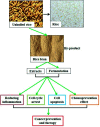The anti-cancer activity and potential clinical application of rice bran extracts and fermentation products
- PMID: 35520585
- PMCID: PMC9064785
- DOI: 10.1039/c9ra02439e
The anti-cancer activity and potential clinical application of rice bran extracts and fermentation products
Abstract
Rice bran is the main by-product of rice processing and contains approximately 64% of the nutrients in rice. Its various nutrient elements include rice bran proteins, oil, oryzanol, vitamins, polysaccharides, etc. The use of fermented technology can increase the content of bioactive peptides, promote the absorption efficiency, and further improve the functionality and added value of rice bran. In recent years, the nutritional value and function of the extracts and fermented products of rice bran have been emphatically studied. Rice bran extracts and fermentation products serve a critical role in the anti-inflammatory reaction, reducing the plasma lipid effect and increasing anti-cancer activity. Moreover, few review studies have been reported on the anti-cancer activity and potential mechanism of action of rice bran extract and its fermentation products. In this review, we focused on the anti-cancer function, mechanisms, and potential clinical usage of rice bran extracts and fermentation products in the adjuvant therapy of cancer patients.
This journal is © The Royal Society of Chemistry.
Conflict of interest statement
The authors declare no conflict of interest.
Figures





Similar articles
-
Comparative Analysis of γ-Oryzanol, β-Glucan, Total Phenolic Content and Antioxidant Activity in Fermented Rice Bran of Different Varieties.Nutrients. 2017 Jun 3;9(6):571. doi: 10.3390/nu9060571. Nutrients. 2017. PMID: 28587204 Free PMC article.
-
Amended final report on the safety assessment of Oryza Sativa (rice) Bran Oil, Oryza Sativa (rice) Germ Oil, Rice Bran Acid,Oryza Sativa (rice) Bran Wax, Hydrogenated Rice Bran Wax, Oryza Sativa (rice)Bran Extract, Oryza Sativa (rice) Extract, Oryza Sativa (rice) Germ Powder, Oryza Sativa (rice) Starch, Oryza Sativa (rice) Bran, Hydrolyzed Rice Bran Extract, Hydrolyzed Rice Bran Protein, Hydrolyzed Rice Extract, and Hydrolyzed Rice Protein.Int J Toxicol. 2006;25 Suppl 2:91-120. doi: 10.1080/10915810600964626. Int J Toxicol. 2006. PMID: 17090480 Review.
-
Phenolic profile and antioxidant activity of extracts prepared from fermented heat-stabilized defatted rice bran.J Food Sci. 2014 Nov;79(11):H2383-91. doi: 10.1111/1750-3841.12658. Epub 2014 Oct 11. J Food Sci. 2014. PMID: 25307751
-
Polysaccharides from Ganoderma Sinense - rice bran fermentation products and their anti-tumor activities on non-small-cell lung cancer.BMC Complement Med Ther. 2021 Jun 10;21(1):169. doi: 10.1186/s12906-021-03346-7. BMC Complement Med Ther. 2021. PMID: 34112172 Free PMC article.
-
A Short Review: Bioactivity of Fermented Rice Bran.J Oleo Sci. 2021 Nov 3;70(11):1565-1574. doi: 10.5650/jos.ess21190. Epub 2021 Oct 12. J Oleo Sci. 2021. PMID: 34645751 Review.
Cited by
-
Lactobacillus acidophilus-Fermented Germinated Brown Rice Suppresses Preneoplastic Lesions of the Colon in Rats.Nutrients. 2019 Nov 9;11(11):2718. doi: 10.3390/nu11112718. Nutrients. 2019. PMID: 31717536 Free PMC article.
-
Investigating the Potential Synergistic Effects of Turmeric Extract and Black Rice Bran as Cytotoxic Agents Against HeLa Cells.Asian Pac J Cancer Prev. 2025 Mar 1;26(3):1059-1067. doi: 10.31557/APJCP.2025.26.3.1059. Asian Pac J Cancer Prev. 2025. PMID: 40156425 Free PMC article.
-
Recent advances in novel targeting mechanisms for colorectal cancer.Clin Transl Oncol. 2025 Jul 11. doi: 10.1007/s12094-025-03990-2. Online ahead of print. Clin Transl Oncol. 2025. PMID: 40643867 Review.
-
Contemporary Views of the Extraction, Health Benefits, and Industrial Integration of Rice Bran Oil: A Prominent Ingredient for Holistic Human Health.Foods. 2024 Apr 24;13(9):1305. doi: 10.3390/foods13091305. Foods. 2024. PMID: 38731675 Free PMC article. Review.
-
Anthocyanins in Red Jasmine Rice (Oryza sativa L.) Extracts and Efficacy on Inhibition of Herpes Simplex Virus, Free Radicals and Cancer Cell.Nutrients. 2022 May 1;14(9):1905. doi: 10.3390/nu14091905. Nutrients. 2022. PMID: 35565872 Free PMC article.
References
-
- Saikia D. Deka S. C. Int. Food Res. J. 2011;18:21–30.
-
- Weerathilake W. A. D. V., Ranawana S. S. E., Abeynayake N. R., Perera A. N. F. and Wijeratne W. M. M. P., 2012
-
- Laokuldilok T. Rattanathanan Y. Cereal Chem. 2014;91:560–565. doi: 10.1094/CCHEM-02-14-0022-R. - DOI
Publication types
LinkOut - more resources
Full Text Sources

